Siegfried class battleships (1889)
 Germany (1889)
Germany (1889)
Siegfried, Beowulf, Frithjof, Heimdall, Hildebrand, Hagen, Odin, ägir
A first step for a young navy
The Siegfried class battleships were a bit of a testimony of the humble beginnings of the German Navy. The young Kaiserliches Marine emerged in 1870 from the aggregation of several navies, inherited from various political entities which went back to the “Holy Roman Empire”. The 1870s fleet (after the Franco-Prussian war, that ended with the unification of the German Empire) was composed of the ironclad ram Prinz Adalbert (1865), turret ship Arminius (1863), and central battery ironclads Friedrich Carl, Kronprinz, König Wilhelm, and Hansa (1872). The latter was the first major warship to be built in Germany, at Dantzig Dyd. All the others were either French or British-built. Following these were the Grosser Kurfürst class, three central battery ironclad (1873) and two Kaiser class (1874), and the four Sachsen (1877) and single Oldenburg (1884). All were discarded before ww1. So the new ships inaugurated a turreted modern design, that will be followed by the Brandenburg class from 1891.
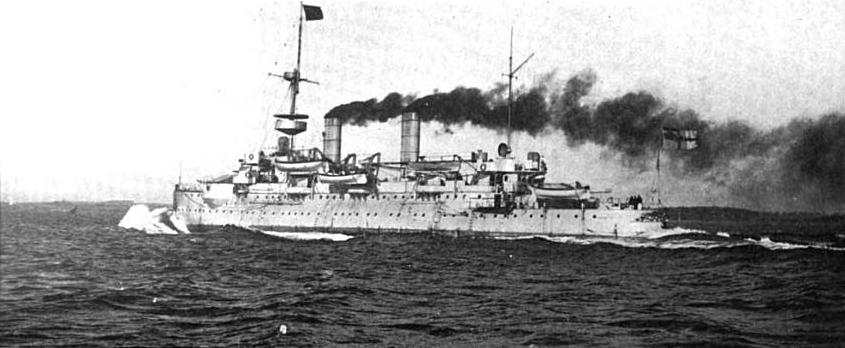
The Hagen underway after reconstruction, prior to WW1
Symptoms of the philosophy before the arrival on the throne of Wilhelm II and his personal naval ambitions, these coastal battleships had no other vocation than the defense of the major German ports of the Baltic. Their dimensions allowed only for a modest armament, and they were comparable to the small capital units developed by the Scandinavian navies of the era. The German admiralty ordered these series in 1888-1893, launched in 1889-95 and accepted in 1890-96. They were ordered at Germaniawerft (1), Weser (2), Wilhelmshaven (1), Kiel Dyd (3) and Dantzig Dyd (1), private and government shipyards. All these ships, after the Hagen from 1898 which inaugurated the new design, were completely rebuilt in 1900-1904. Two 88 mm guns were added, the hulls were lengthened to 86.5 m, new boilers traduced by two funnels and a tonnage rising to 4,158 tons.
Design
Their configuration was singular, with three standard heavy guns, of which two were at the front on each side, and one at the rear, centerline. The Odin and Aegir, the last two ships, differed by a secondary armament comprising 10 x 88 mm, four 450 mm TTs, the armor, the two funnels and military masts. Thes ships were small, 76.40 meters at the waterline and 79 m long overall by 14.90 m (48 ft 11 in) and 5.51-5.74 m draft. The ships used transverse and longitudinal steel frames in the hull. They had eight watertight compartments and a double bottom that ran for 60% of the hull. After the refits, one more watertight compartment was added. The ships were described as good sea boats. They had gentle motion and were very responsive to commands from the helm but lost significant speed in heavy seas.
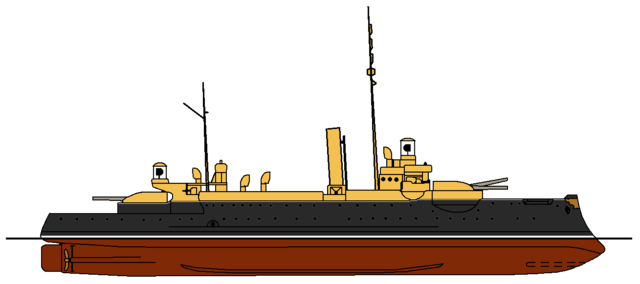
The SMS Siegfried before construction (wikimedia commons)
Armor
Protection consisted of compound steel (first three ships) or Krupp armor (the others backed by teak planking. The upper main armored belt was 240 millimeters (9.4 in) thick reduced to 180 mm (7.1 in) on both ends backed by 330 mm (13 in) of timber. The lower belt was 140 mm (5.5 in) thick, 100 mm (3.9 in) on both ends and backed by 290 mm (11 in) of timber. The main deck was 30 mm (1.2 in) thick up to 50 mm (Hagen and Heimdall) while the conning tower top was 30 mm (1.2 in) thick with 80 mm (3.1 in) sides up to 160 mm on the same ships. The hull sections also had a pronounced tumblehome in accordance to the fad of the era.
Propulsion
The Siegfrieds were powered by two 3-cylinder triple expansion engines, with their respective engine room, driving a pair of three-bladed screws 3.50 m in diameter. These TE engines were fed by eight German mixed-fired admiralty boilers. However Hagen had eight British-built Thornycroft boilers instead. Top speed, as observed in trials were about the same, Beowulf being the fastest at 15.1 knots (28.0 km/h; 17.4 mph) but it fall at 14.6 knots (Heimdall). In addition to the powerplant, three electric generators provided 29 to 26 kilowatts@ 67 volts and carried up to 220 t of coal and 220 t of fuel oil which maximized available space, for a total 1,490 nautical miles (2,760 km; 1,710 mi) at a cruising speed of 10 knots (19 km/h; 12 mph). At 14 knots (26 km/h; 16 mph), the ships could only steam 740 nmi (1,370 km; 850 mi). The refit allowed larger holds, so total bunkerage rose to 580 t of coal and 500 t of fuel oil, rising their autonomy to 3,400 nautical miles at 10 knots.
Armament
Primary armament: 3 turrets with single 24-centimetre (9.4 in) K L/35 guns in a triangular arrangement inside MPL C/88 turrets. Traverse was 150 degrees on the broadside from the centerline, with a depression/elevation of −4 degrees/25 degrees. Maximum range was 13,000 m (43,000 ft), ammunition storage was 204 rounds, and these guns had a rate of fire of about 2 shells per minute, firing 1895 shell models, armor-piercing 140 kg (310 lb).
Secondary armament: Eight 8.8 cm (3.5 in) SK L/30 guns (Siegfried six), 1,500 rounds of ammunition, the shells were 10 kg (22 lb) fired at a muzzle velocity of 590 m/s (1,936 m/s) and about 15 rounds per minute. Six machine guns were also fitted for some time. For close-quarters, four 35 cm (14 in) torpedo tubes were installed in the stern (above-water swivel mount), two laterally above water, and a fourth in the bow. 10 torpedoes were carried as reloads.
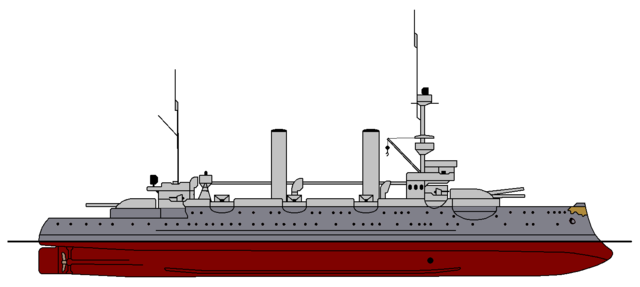
SMS Hagen in 1910, after reconstruction
Reconstruction
These ships were rebuilt through extensive refits between 1898 and 1904, the major changes consisting on having the hull lengthened to 86.13 m (282 ft 7 in) overall, and the draft slightly reduced to 5.45 m. Displacement rose to 3,500 metric tons, fully loaded at 3,741 t (3,682 long tons) and between 4,000 to 4,436 t (3,937 to 4,366 long tons) depending on the ship after 1910. Also after the refit they all received ten 8.8 cm guns and 2,500 rounds in storage rather than 1,500. Also stern and lateral tubes were replaced with 45 cm tubes, while lateral TTs were moved underwater submerged with 8 torpedoes in storage plus three for the bow tube.
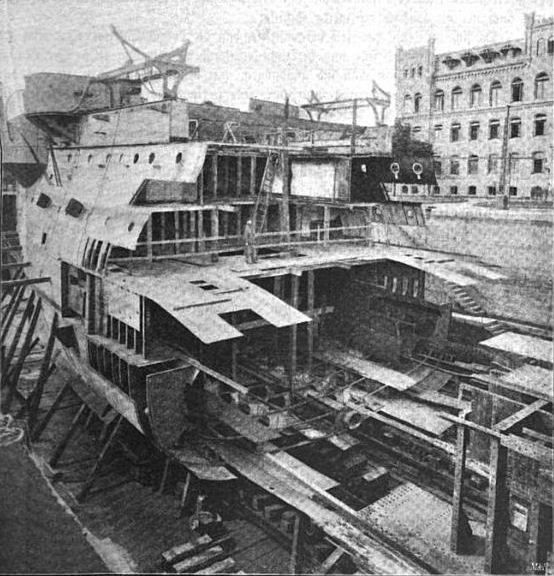
SMS Hagen during reconstruction
Active service
In 1914, these eight ships consituted the sixth squadron of Rear-Admiral Eckermann in the Kaiserliches Marine. In 1915 they were demoted as local coast guards ships with a reduced crew until 1916 when they were completely disarmed. They were sold in 1919. Although four were broken up in 1919-1921 (the SMS Hildebrand was stranded on a Dutch sandbank during her transfer), the Beowulf served briefly as an ice-breaker. The Frithjof, Odin and Aegir were converted into cargo ships and survived until 1929-35.
The Odin class (1893)
This class is sometimes separated from the main coastal battleship class, although they are very similar. Conway’s doesn’t do the distinction. Just like the previous ships they were named after Norse god Odin and Ägir (or Aegir in modern German). They had eight watertight compartments and a double bottom for about 60% of the length of the hull and were considered better seaboats, although slower. They also had the same propulsion system and three electric generator units. However Aegir innovated and was sometimes nicknames “Electrische Anna” because of her increased number or power generator giving 243–250 kW at 120 V. Armament was identical, but for protection they had their main main battery barbettes and cupolas between 30 to 200 mm (1.2 to 7.9 in) thick backed by 200 mm (7.9 in) of teak.
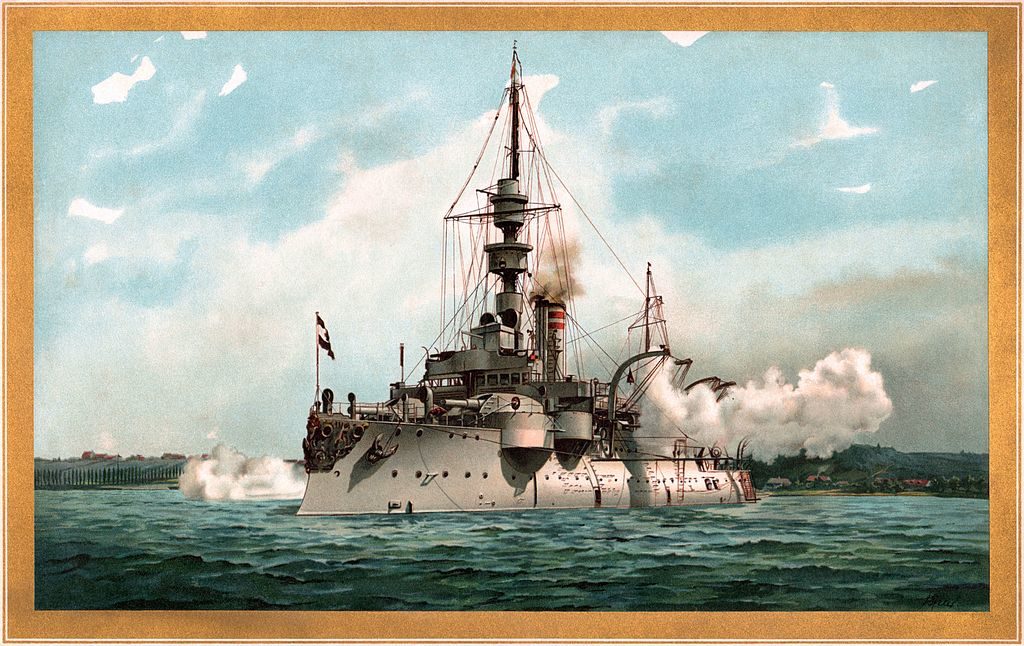
SMS Odin in 1900
Both ships saw limited service after reconstruction because of the revolution brought up by the Dreadnought. A Second Naval Law (1908) therefore reduced their service life to 20 years and therefore Odin-class ships and the previous class were to be replaced by the Kaiser-class battleships.However the class was maintained in service for coastal defense but was withdrawn from active service in 1915. Odin was converted as a tender in Wilhelmshaven, struck on 6 December 1919 and sold to A. Bernstein Co. (Hamburg) and then converted as a freighter from 1922, while being finally scrapped in 1935. Ägir was also based at Wilhelmshaven, served as a barracks ship, was stricken on 17 June 1919, sold to the same Hamburg company and used also as a freighter until 1929 when she was grounded off the Karlsö lighthouse (Gotland Island). She was declared unsalvageable and later broken up in site, her bow ornament surviving to be displayed today at the Laboe Naval Memorial.
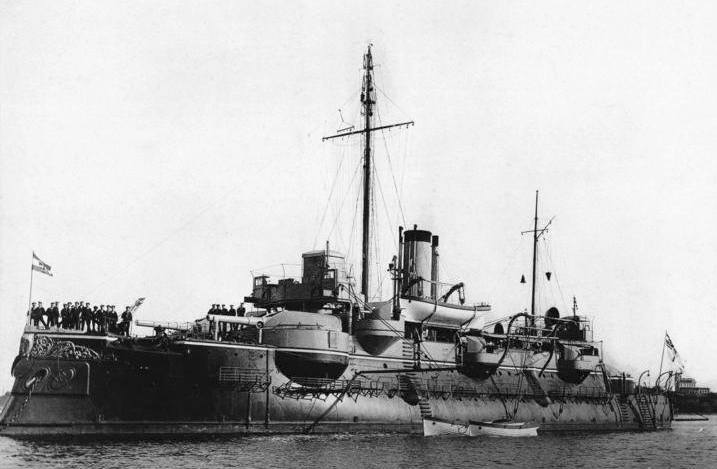
SMS beowulf in the 1890s
Links
wikipedia.org/wiki/Siegfried-class_coastal_defense_ship
wikipedia.org/wiki/Odin-class_coastal_defense_ship
http://www.kaiserliche-marine.de
http://www.sms-navy.com/
http://www.fr.naval-encyclopedia.com/1ere-guerre-mondiale/Kaiserliche-Marine.php
Specs Conway’s all the world fighting ships 1860-1905, 1906-1921.
Siegfired specifications (before refit) |
|
| Dimensions | 76.40/79 m x 14.90 m x 5.70 m (259 ft 2 in x 48 ft 11 in x 18 ft 8 in) |
| Displacement | 3,500 metric tons (3,400 long tons) |
| Crew | 280 |
| Propulsion | 2 screws, 2 VTE engines, 6 boilers, 4,800 ihp (3,600 kW) |
| Speed | 14.5 knots () |
| Range | 8,870 nmi (16,430 km, 10,210 mi) 19 knots (35 km/h, 22 mph) |
| Armament | 3 x 240mm, 10 x 88mm, 4 TLT 450 mm (SM: fore, aft, 2 sides) |
| Armor | Turrets 203, belt 230, blockhaus 230, barbettes 203 mm |
Gallery
Illustration of the SMS Siegfried by the author

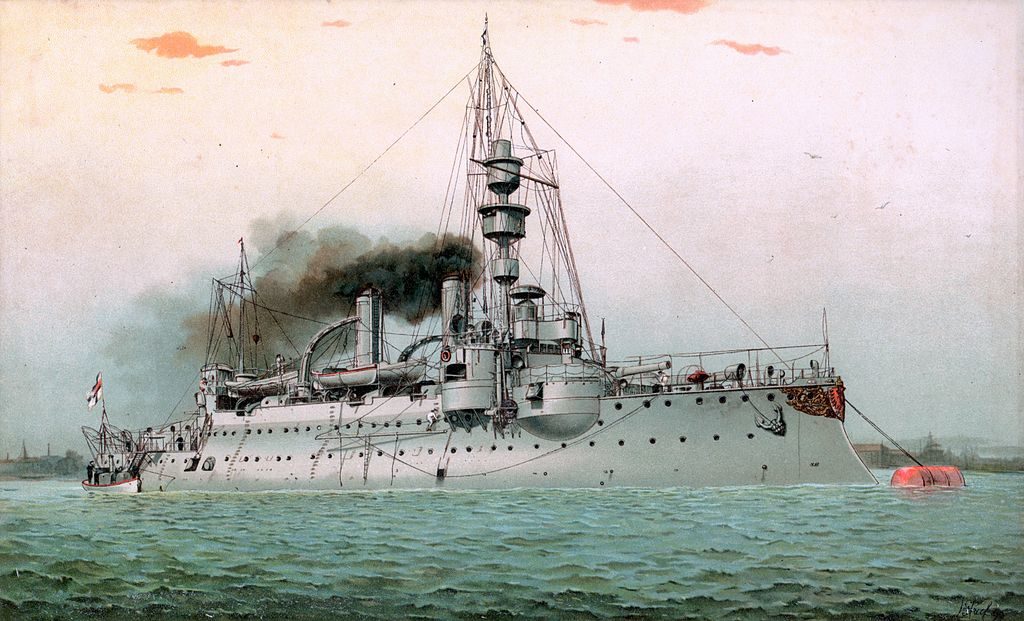
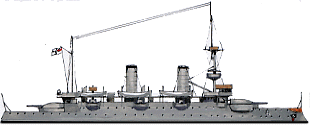
 Latest Facebook Entry -
Latest Facebook Entry -  X(Tweeter) Naval Encyclopedia's deck archive
X(Tweeter) Naval Encyclopedia's deck archive Instagram (@navalencyc)
Instagram (@navalencyc)





 French Navy
French Navy Royal Navy
Royal Navy Russian Navy
Russian Navy Armada Espanola
Armada Espanola Austrian Navy
Austrian Navy K.u.K. Kriegsmarine
K.u.K. Kriegsmarine Dansk Marine
Dansk Marine Nautiko Hellenon
Nautiko Hellenon Koninklije Marine 1870
Koninklije Marine 1870 Marinha do Brasil
Marinha do Brasil Osmanlı Donanması
Osmanlı Donanması Marina Do Peru
Marina Do Peru Marinha do Portugal
Marinha do Portugal Regia Marina 1870
Regia Marina 1870 Nihhon Kaigun 1870
Nihhon Kaigun 1870 Preußische Marine 1870
Preußische Marine 1870 Russkiy Flot 1870
Russkiy Flot 1870 Svenska marinen
Svenska marinen Søværnet
Søværnet Union Navy
Union Navy Confederate Navy
Confederate Navy Armada de Argentina
Armada de Argentina Imperial Chinese Navy
Imperial Chinese Navy Marinha do Portugal
Marinha do Portugal Mexico
Mexico Kaiserliche Marine
Kaiserliche Marine 1898 US Navy
1898 US Navy Sovietskiy Flot
Sovietskiy Flot Royal Canadian Navy
Royal Canadian Navy Royal Australian Navy
Royal Australian Navy RNZN Fleet
RNZN Fleet Chinese Navy 1937
Chinese Navy 1937 Kriegsmarine
Kriegsmarine Chilean Navy
Chilean Navy Danish Navy
Danish Navy Finnish Navy
Finnish Navy Hellenic Navy
Hellenic Navy Polish Navy
Polish Navy Romanian Navy
Romanian Navy Turkish Navy
Turkish Navy Royal Yugoslav Navy
Royal Yugoslav Navy Royal Thai Navy
Royal Thai Navy Minor Navies
Minor Navies Albania
Albania Austria
Austria Belgium
Belgium Columbia
Columbia Costa Rica
Costa Rica Cuba
Cuba Czechoslovakia
Czechoslovakia Dominican Republic
Dominican Republic Haiti
Haiti Hungary
Hungary Honduras
Honduras Estonia
Estonia Iceland
Iceland Eire
Eire Equador
Equador Iran
Iran Iraq
Iraq Latvia
Latvia Liberia
Liberia Lithuania
Lithuania Mandchukuo
Mandchukuo Morocco
Morocco Nicaragua
Nicaragua Persia
Persia San Salvador
San Salvador Sarawak
Sarawak Uruguay
Uruguay Venezuela
Venezuela Zanzibar
Zanzibar Warsaw Pact Navies
Warsaw Pact Navies Bulgaria
Bulgaria Hungary
Hungary

 Bundesmarine
Bundesmarine Dutch Navy
Dutch Navy Hellenic Navy
Hellenic Navy Marina Militare
Marina Militare Yugoslav Navy
Yugoslav Navy Chinese Navy
Chinese Navy Indian Navy
Indian Navy Indonesian Navy
Indonesian Navy JMSDF
JMSDF North Korean Navy
North Korean Navy Pakistani Navy
Pakistani Navy Philippines Navy
Philippines Navy ROKN
ROKN Rep. of Singapore Navy
Rep. of Singapore Navy Taiwanese Navy
Taiwanese Navy IDF Navy
IDF Navy Saudi Navy
Saudi Navy Royal New Zealand Navy
Royal New Zealand Navy Egyptian Navy
Egyptian Navy South African Navy
South African Navy






























 Ukrainian Navy
Ukrainian Navy dbodesign
dbodesign